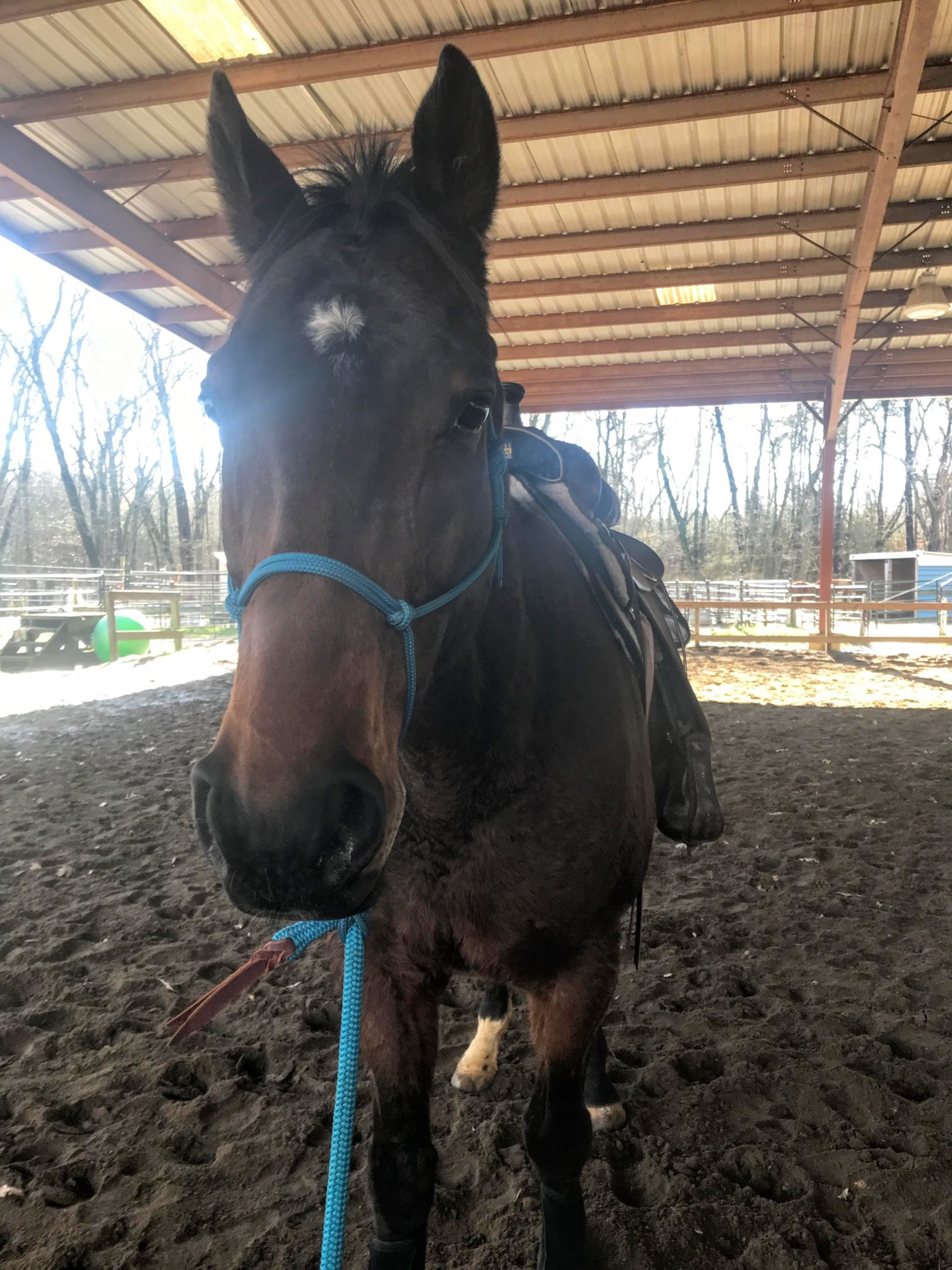Have you ever had trouble getting your horse to stand still? In the barn? For the farrier? On the trails? Does your horse have trouble tying or standing cross-tied? There’s a simple, practical skill you can work on teaching your horse to help with all of those issues… it’s called ground tying.
What is Ground Tying?
Ground tying is the skill of standing still on command when not tied to anything, essentially relying on the weight of a lead line or loose reins to “tie” them to the ground. Some articles say this skill demonstrates a “high level of obedience” but in reality, it’s a learned skill and behavior, not a sign of submission.
You might be wondering why practicing this skill would be useful and to be honest, I have a hard time thinking of situations where having this skill wouldn’t be useful. Imagine yourself on the trails and for whatever reason you need to hop off. If your horse doesn’t ground tie chances are you’ll end up needing to tie him, have someone to hold him, or he’ll just wander away. Ground tying fixes that problem without the need to hard tie.
Even for show jumpers and eventers, having a horse that ground ties can come in handy whenever you’re getting ready for shows or being able to tack up your horse without needing someone to help or hold your horse.
Craig Cameron, an excellent teacher and horseman, published a short video on this subject. BUT (and this is a big but) this video really doesn’t offer you many solutions or exercises for how to improve or work on this skill. We’ll get to that!
Realistically ground tying can be helpful with every aspect of ground handling and having other people like vets or farriers safely handle your horse. It even helps with things like putting brakes on your horse and training them to stand calmly and still with you on their back.
Is It More Difficult to Teach a Retired Racehorse to Ground Tie?
Simple answer to this question — absolutely not. In fact, I hate to generalize or be too overly Thoroughbred-biased but racehorses, especially those with competition and training history, demonstrated at some point in their lives a willingness and the ability to learn a skill. That skill happened to be racing, this skill happens to be standing still. While polar opposite goals, that willingness to learn is really all you need to start teaching ground tying regardless of how frequently they raced. If a horse can learn, they can also learn to stand still with time, practice, and patience.
In retrospect it’s something I wish I’d been more diligent about training with my OTTB from day 1. Like most racehorses fresh off the track, mine made it clear he wasn’t a fan of being tied or standing calmly in the barn. Especially for retired racehorses who might not have experience on cross ties, teaching an OTTB to ground tie can be an excellent first step in this process. Once the mission of “stand still” is understood, we can continue conditioning for relaxation and desensitizing in other environments like a barn, only this time it will be a whole lot easier than just hoping it goes smoothly.
Practicing Ground Tying
While researching this article I read so many other articles and watched just about every YouTube video I could find on the subject… and I’ll be honest — you’re never going to be able to teach a horse to ground tie in under three minutes as the length of some of these videos and articles might suggest. It isn’t going to happen that quickly, it won’t happen overnight, and if it does count your lucky stars because you’ve probably acquired a horse that has had some practice at this before.
To start teaching your horse to ground tie we need to condition for relaxation and desensitize from the ground similar to what we discussed in my last update with Indy. You’ll need a rope halter and a long lunge line to get started and can begin practicing either loose in the round pen or on the line.
Start by lunging, however you normally would. My normal routine is a walk (either on the lead, by hand, or in the round pen) and working up to 5-10 minutes of trotting, changing directions half way through, and finishing with a few minutes at a canter in both directions before starting some desensitizing work. This can be done either on the line or in a round pen, whatever floats your boat. I start with a walk for a few reasons, namely being that I don’t want to encourage the idea of “we start work by hauling ass and actin’ a fool” and starting our work with a walk definitely helps form that association. Once we’ve had a little warm up, we work up to a trot and canter.
Pairing the practice of ground tying with lunging is kind of essential because it makes your mission incredibly clear, nearly black and white — stand still, regardless of what’s going on around you, otherwise I’ll make you move and then we’ll try again. The “standing still regardless of what’s going on around you” part of that conversation is the desensitizing aspect of ground tying. Similar to some of Pat Parelli’s seven games and especially the “friendly game”. This is a simple way of communicating your intentions that they have them remain standing in the same place.
To practice desensitizing and a little of this friendly game, either drop your lead rope on the ground or remove it completely while letting out your usual “whoa” just as you would under saddle asking for a stop. Developing this cue and forming the association with your “whoa” or “stay” is essential because it lets the horse know what we’re doing and the only way to build that connection is through repeated practice. A little Pavlov’s dog effect if you will. It’s also a great time to practice sensitivity to pressure from the halter because if the horse is really sensitive to pressure, in theory just the weight of the line should be enough to hold him or her in place.
After bringing your horse to a stop and letting out an audible sigh or “whoa” approach either side of your horse’s neck. Starting with just a hand on your horse, pat and rub your way from his neck down to his rear and continue around his hind end and up the other side. Picture your horse standing like a statue throughout this process. I know it sounds crazy but visualization helps. Reverse your direction keeping a hand on the horse so he’s aware of where you are in relation to him and repeat until the horse is calm and still during this process consistently. Once they’ve mastered just your hands, work up to keeping one hand on the horse while flipping a whip or stick at his sides to begin desensitizing.
Whenever you’re desensitizing your movements shouldn’t be erratic or flailing. Start with one hand on the horse and the other with a stick and begin lightly tapping the ground with the stick, saying “whoa” if the horse gets a little jumpy. If the horse moves its feet correct with pressure or the lead line and try tapping again. If your horse seems to be alright standing on his/her own through this you can remove your hand and do the same thing, tapping the stick or flipping a whip while walking around until the horse is calm and unfazed by it.
Here’s a video of the friendly game using a stick with a long rope to desensitize.
There’s no reason for a horse’s feet to be moving during this little ring-around-the-rosie, regardless of whether we’re doing anything else. If they do move, and if your horse isn’t familiar with this game then they almost certainly will, just move their feet back into place either using pressure from your hands (similar to the porcupine game from Parelli) or using the lead rope.
The key here is not to be frustrated and know your proverbial plan b. If the horse is too worked up, too unwilling to stand still, then accommodate those needs by switching gears. Go back to lunging, making their feet move, until all of a sudden standing still becomes something the horse is seeking, not avoiding. This is the rinse and repeat of practicing ground tying – trying, correcting, trying again, moving their feet until they want to stand still, try again, correct again.
Rinse, repeat, and most importantly reward when they’ve gotten it right. Call it a night or change gears for the day when they’ve finally stood still long enough for you to walk away or when they’ve stopped caring about your stick. Turn short, small victories into larger ones by building on them, not forcing them overnight.
Gradually the idea with ground tying is that in theory, the day should come where you’ll be able to say “whoa” and have your horse associate this with “I get to stand here now.” In theory, haha! Then again, every day is another chance to practice. In an ideal world you’ll go from needing a hand on the horse to being able to walk around hands free, knowing that your horse understands his job is to stand still. After all standing still is one of the easiest things we can ask our horses to do! Sometimes they just need a little help understanding that.
Have any questions or tips and tricks to get your horse to ground tie? Share yours in the comments below!


Pingback: One Year With An OTTB: Oh The Things We’ve Learned – Diary of an OTTB
Stumbled upon your blog and this today. I have an OTTB that is 12 and I thought he knew all the things when I purchased, but he definitely does not- particularly standing still is hard and dangerous around the farrier. We’ve just started the Parelli games as he is just missing some of the basics. Thank you for this article. For one, it lets me know I’m not alone! And, everything you are saying absolutely makes sense. I’ve had a hard time with a trainer who clearly knew nothing about off track horses and pointed out his every flaw to me. Now I have a plan to conquer. Thank you!